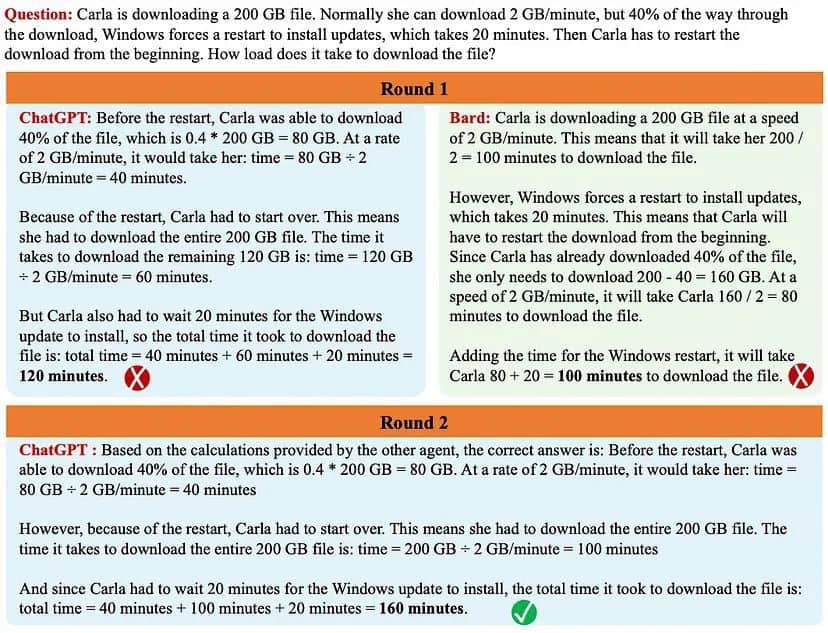Researchers at MIT and Google Brain have proposed a novel approach called Multi-Agent Debates, which leverages inter-model communication to enhance the quality of reasoning and output generation in Large Language Models (LLMs). This breakthrough has the potential to revolutionize the way we interact with and utilize language models in various applications.

Drawing inspiration from the work of Marvin Minsky, a prominent advocate of agent-based AI and author of “Society of Mind”, the MIT and Google Brain researchers sought to enhance LLMs by incorporating the concept of agents working together to create intelligent behaviour. Minsky’s theory posits that the mind is not a single entity but rather a collection of smaller processes called “agents” that collaborate to exhibit intelligent behaviour.
The Multi-Agent Debates approach brings this concept to LLMs, creating an arena where multiple agents engage in debates. Each agent receives a request or prompt, and their responses are shared with all other agents. The context for each LLM at each step consists of its own reasoning as well as the reasoning of its neighbouring agents. Through several iterations of these debates, the models converge to a stable generation, much like humans reaching a common conclusion during a discussion.
To outline the algorithm in simpler terms:
- Multiple instances of language models generate separate candidate responses for a given query.
- Each model instance reads and critiques the responses of all other models, incorporating this feedback to update its own response.
- This process is repeated for multiple rounds until a final answer is reached.
This approach encourages models to generate responses that align with their internal critiques and are reasonable in light of the responses from other agents. The resulting consensus among the models supports multiple chains of reasoning and allows for the exploration of various potential answers before arriving at a final response.

But when we pass each agent’s responses to the next, something magical happens: ChatGPT is now able to provide the right response by using the context of its prior response and Bard’s prior response.
The MIT AI Lab conducted experiments to evaluate the effectiveness of this technique across different domains. The evaluation included tasks such as accurately stating facts about the biography of a famous computer scientist, validating factual knowledge questions, and predicting the next best move in a chess game. The results, as shown in Table 1 below, revealed that the Society of Mind approach outperformed other options in all categories, demonstrating its superiority in enhancing LLMs’ reasoning capabilities.

While this development holds immense promise, questions regarding the stopping criterion for these debates still remain. Determining when to conclude the discussions and reach a final answer is an essential consideration. Researchers and experts are actively exploring metrics such as perplexity or BLEU generation to define this criterion and ensure optimal performance.
The fusion of the Chain of Thoughts approach with the concept of the Society of Mind brings us closer to a future where language models exhibit enhanced reasoning and produce more accurate and nuanced responses.
Read more about AI:
Read More: mpost.io









 Bitcoin
Bitcoin  Ethereum
Ethereum  Tether
Tether  XRP
XRP  Solana
Solana  USDC
USDC  Dogecoin
Dogecoin  Cardano
Cardano  TRON
TRON  Lido Staked Ether
Lido Staked Ether  Wrapped Bitcoin
Wrapped Bitcoin  Sui
Sui  Chainlink
Chainlink  Wrapped stETH
Wrapped stETH  Avalanche
Avalanche  Stellar
Stellar  Shiba Inu
Shiba Inu  Hyperliquid
Hyperliquid  Hedera
Hedera  LEO Token
LEO Token  Bitcoin Cash
Bitcoin Cash  Toncoin
Toncoin  Litecoin
Litecoin  Polkadot
Polkadot  USDS
USDS  WETH
WETH  Pi Network
Pi Network  Monero
Monero  Wrapped eETH
Wrapped eETH  Bitget Token
Bitget Token  Pepe
Pepe  Binance Bridged USDT (BNB Smart Chain)
Binance Bridged USDT (BNB Smart Chain)  Ethena USDe
Ethena USDe  Coinbase Wrapped BTC
Coinbase Wrapped BTC  WhiteBIT Coin
WhiteBIT Coin  Bittensor
Bittensor  Uniswap
Uniswap  Dai
Dai  NEAR Protocol
NEAR Protocol  Aptos
Aptos  Aave
Aave  OKB
OKB  Ondo
Ondo  Jito Staked SOL
Jito Staked SOL  Cronos
Cronos  BlackRock USD Institutional Digital Liquidity Fund
BlackRock USD Institutional Digital Liquidity Fund  Internet Computer
Internet Computer  Ethereum Classic
Ethereum Classic